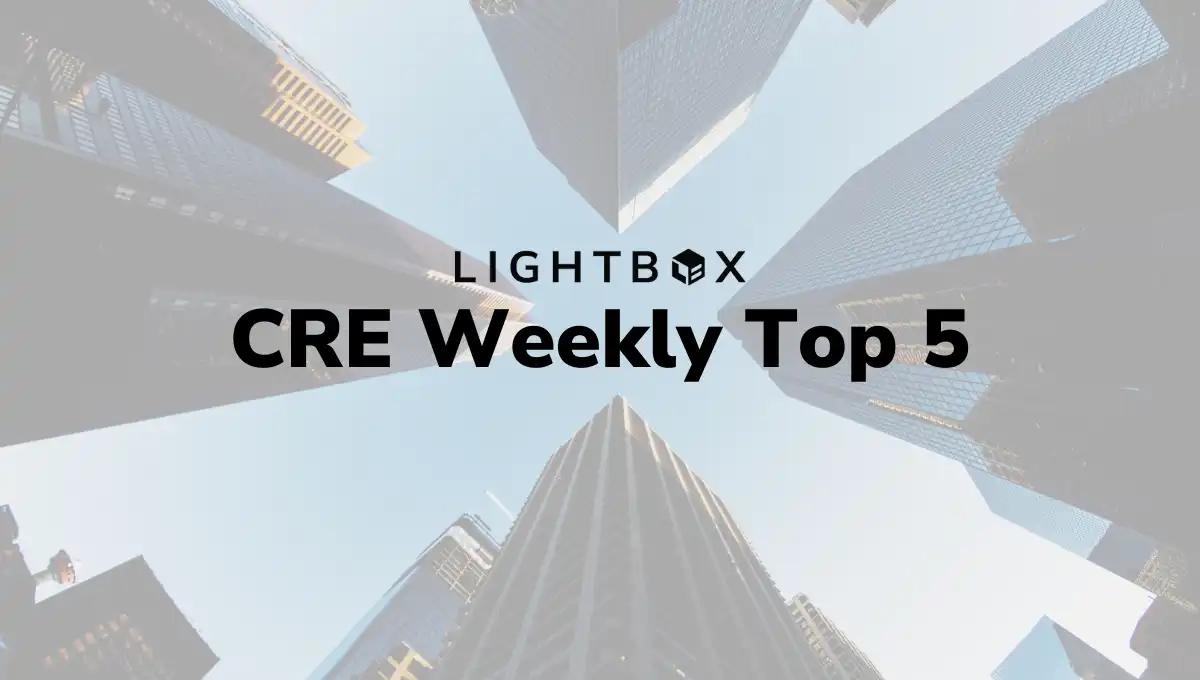For the week of Sept. 9-13, 2024
The September Fed meeting took center stage this week with a bold 50 basis point (bps) cut in interest rates, but other headlines about retail sales, the housing market, leases, and transactions also deserve some attention.
Here’s our latest top 5 list of the biggest weekly CRE news stories and why they matter.
- Fed comes out of the gate with an expected, yet bold, interest rate cut.
Heading into this week’s Fed meeting, against the backdrop of mixed signals from the market, the betting field was fairly evenly split between those expecting a traditional 25 bps drop and those forecasting a more aggressive 50 bps cut. The latter won the wager. After any Fed meeting, the decision on rate action is as important as the commentary. Fed Chairman Powell called the move a “recalibration of our policy that will help maintain the strength of the economy and the labor market and will continue to enable further progress on inflation as we begin the process of moving toward a more neutral stance.”
Why It Matters: While the cut was expected, the magnitude raised some eyebrows. Previous cuts of this size or higher historically occur during periods of heightened volatility (e.g., the Dot-com bust, the Global Financial Crisis, and the COVID-19 pandemic). The first rate cut in 2 years delivers a psychological impact to the CRE market, a concrete sign that the long-awaited rate cutting cycle is now underway. Investor demand and refinancing opportunities will likely increase as borrowing costs decline slowly over the coming months. With inflation finally cooling, the Fed’s focus shifts to managing against the risks of a potential weakening in labor markets. The next meeting on the horizon is November 6-7, occurring after two more months of labor market data which will play an important role in the next rate decision.
- Retail sales increased in August, a small but meaningful surprise on the upside.
Data on retail sales continue to make headlines, and this week the news was a pleasant surprise. Retail sales posted a surprise (albeit modest) 0.1% gain in August over July. The increase was largely supported by online purchases that masked mixed results from brick-and-mortar retailers.
Why It Matters: Retail sales are directly related to the health of the U.S. economy so the latest round of data paints a reassuring picture of the resilience of consumer spending despite reports earlier this month of major retailers falling short of their sales forecasts . Every positive report of retail sales mitigates fears of a recession, so it will be interesting to see whether shoppers remain cautious and cost-sensitive as the holiday season approaches.
- Promising Signs of a Thaw in the Housing Market
The U.S. Census Bureau reported that single-family housing starts in August came in at a healthy 15.8% above the revised July estimate, and building permits for single-family housing, a widely watched leading indicator, were 2.8% above July’s figure. Builder confidence is improving from its record-low early this year, but the sector still faces challenges from the labor shortage, zoning restrictions, and regulatory policies.
Why It Matters: The home construction market has struggled in recent years from a spike in the cost of labor and materials, as well as the weight of high interest rates on the cost of borrowing for builders and home buyers. As interest rates decline, it will ease some of the pressure on homebuyers with more affordable borrowing costs, in addition to providing some relief to construction costs.
- The LightBox Phase I ESA Activity Index
The daily average for U.S. Phase I environmental site assessments (ESA) activity in July and August, based on output from LightBox’s ScoreKeeper model, increased by a solid 11% compared to last summer and 4% above May and June. Consistent with this positive trend, 73% of the environmental consultants on the LightBox Market Advisory Council expect somewhat higher Phase I ESA volume in Q3.
Why It Matters: Environmental due diligence activity is a leading indicator of CRE activity since Phase I ESAs are required prior to any major CRE loan or property deal. If September data comes in strong, the LightBox Phase I ESA Activity Index in Q3 could beat Q2’s 87.3, which was up 10.3 above Q1. Another strong quarterly uptick would raise hopes for a busier end to 2024. The caveats of course are the uncertainty leading up to Election Day, as well as any impact the November and December Fed meetings could have on lending and investment activity.
- Major Chicago tenant triples office space, CalSTRS inks major apartment deal.
In green shoots this week was a major office lease and a promising deal in multifamily. In news from Chicago, Medline, a leader in the medical supply sector, tripled its downtown office space at The Mart in the CBD and added another 210,000 square feet of new space in nearby Northbrook. Also in Chicago, Capital One finalized a new lease for approximately 150,000 square feet at 77 W. Wacker Drive, extending its commitment on the 51-story office tower through 2035. On the sales transactions front, CalSTRS sold Canyon Rim, a garden-style apartment community for $225 million in San Diego at a 52.6% net internal rate of return.
Why It Matters: While owners of some office assets are struggling, employers in growing sectors are shopping around for attractive office locations for their expanding employee base near major downtowns. In multifamily, strong metros like San Diego which have rising rental rates, low vacancy, and a growing population, are attracting investor interest while properties in less attractive metros struggle.
For commentary on these CRE developments and more, tune in to the LightBox CRE Weekly Digest podcast.
Did You Know of the Week
Did you know that that there were 161,326 Phase I ESAs conducted in the U.S. year to date through August according to LightBox’s ScoreKeeper model?
